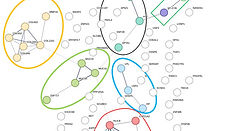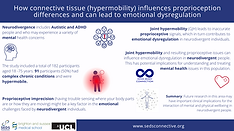top of page
Research
Some key research focussing on the wide range of conditions in hypermobility and neurodivergence both physical and mental and neurodevelopmental
ADHD: overdiagnosis or opportunity?
By Heidi Phillips, Jessica Eccles, Helen Minnis and Jane Green MBE | 25th September 2025
The article discusses the increasing number of ADHD diagnoses and questions whether this trend reflects overdiagnosis or a meaningful opportunity to better identify and help people who genuinely need support.
Emerging research highlights complex brain–body interactions between neurodivergence and connective tissue disorders like joint hypermobility, which are linked to chronic pain, fatigue, and other puzzling physical symptoms. Neurodivergence also frequently overlaps with other neurodevelopmental disorders, including dyspraxia, developmental language disorder, and dyscalculia. These findings underscore the need for holistic and integrated care approaches that address both neurodevelopmental and physical health needs in affected individuals.

A big health study looked at how common a condition called hypermobility Ehlers-Danlos syndrome (hEDS) and Hypermobility Spectrum Disorder (HSD) is in transgender and genderdiverse or gender expansive (TGD) people compared to cisgender people (those whose gender matches the sex they were assigned at birth).
These conditions affect joints and connective tissues, causing pain, fatigue, and other problems. The researchers found that TGD people were much more likely to have hEDS or HSD, about 1 in 38 for those assigned female at birth and 1 in 100 for those assigned male, compared to much lower rates in cisgender people. Whether someone was on hormone therapy didn’t seem to change the chances of having these conditions.
The study suggests that TGD people might face more challenges getting diagnosed and treated, possibly because of stress, discrimination, or more frequent contact with doctors. It also highlights the need for better healthcare that understands both gender identity and complex conditions like hEDS/HSD. The researchers hope this will lead to earlier diagnoses and better support for TGD individuals dealing with these health issues.
.jpg)
Variant connective tissue as a risk factor for long COVID: a case-control study of data from a retrospective online survey of adults in the USA and UK
By Regina A Torok, Jeffrey Lubell, Rena M Rudy, Jessica Eccles, Lisa Quadt | 17th September 2025
Researchers investigated whether joint hypermobility increases the risk of long COVID. They found people with extreme hypermobility may be especially vulnerable, likely due to connective tissue differences and this could help with earlier care in the future.

Defining the Chronic Complexities of hEDS and HSD: A Global Survey of Diagnostic Challenges, Life-Long Comorbidities, and Unmet Needs
By Victoria Daylor, Molly Griggs, Amy Weintraub, Rebecca Byrd, Taylor Petrucci, Matthew Huff, Kathryn Byerly, Roman Fenner + more | 9th August 2025
The largest global, groundbreaking international survey sheds light on the hidden struggles of thousands living with hypermobile Ehlers-Danlos syndrome and Hypermobility Spectrum disorders and the many associated conditions and symptoms including neurodivergence.

They’ve been BITTEN: reports of institutional and provider betrayal and links with Ehlers-Danlos Syndrome (EDS) patients’ current symptoms, unmet needs and healthcare expectations Jennifer Langhinrichsen-Rohling et al (2021)
Many EDS patients reported feeling betrayed by healthcare providers or institutions either through being dismissed, misdiagnosed, or not receiving appropriate care. This betrayal was linked to emotional distress, including anger, anxiety, and a lack of trust in future healthcare.
Nearly half of those with unmet needs described such betrayal, and many had negative expectations about future medical encounters. The study highlights the urgent need for trauma-informed care, better provider education, and more compassionate, knowledgeable support for people with complex conditions like Ehlers-Danlos syndromes

Neural processes linking joint hypermobility and anxiety: key roles for the amygdala and insular cortex
By Christina N. Kampoureli, Charlotte L. Rae, Cassandra Gould Van Praag, Neil A. Harrison, Sarah N. Garfinkel, Hugo D. Critchley and Jessica A. Eccles | 3rd February 2025
This study used brain imaging (fMRI) to investigate how joint hypermobility and anxiety are linked, finding that people with both hypermobility and anxiety show higher activity in the amygdala and insular cortex when viewing emotional faces.

Long-COVID and postural orthostatic tachycardia syndrome: a preliminary comparison of neuropsychological performance
By Aitana Ruiz de Lazcano, Paula Pérez-Núñez, Mercè Pallarès-Sastre, Maddalen García-Sanchoyerto, Irune García & Imanol Amayra | 22nd January 2025
This study found that people with LongCOVID and POTS have worse cognitive function than healthy peers, with working memory, attention and verbal fluency most affected.

“I hear you”. Validation in the context of children's pain as an untapped opportunity to prevent chronic pain
By Sarah B. Wallwork, Chad Shenk, C. Meghan McMurtry, Anna M. Hood, Maria Pavlova', Anneke E. Olson, G. Lorimer Moseley, Melanie Noel | December 2024
This article argues that validating children’s pain by listening and acknowledging their experiences can ease distress and may help stop short-term pain from turning into chronic pain and invalidating their experiences.

When I say … neurodiversity paradigm
By Sebastian Charles Keith Shaw, Megan E. L. Brown, Neera R. Jain, Riya Elizabeth George, Sarah Bernard, Megan Godfrey-Harris, Mary Doherty | 19th November 2024
This article argues that medical education should shift how it sees and supports neurodivergent learners, not as less capable, but as people whose different ways of thinking and learning have value and importantly the language used is important as neurodiversity is all brains in the world being varied.

Decoding the Genetic Basis of Mast Cell Hypersensitivity and Infection Risk in Hypermobile Ehlers-Danlos Syndrome
By Purusha Shirvani, Arash Shirvani and Michael F. Holick | 17th October 2024
New study looks at possible genetic causes of hypermobile Ehlers-Danlos syndrome (hEDS) and related issues like MCAS and higher infection risk. By examining genes, certain genetic variants were found that might play a role in hEDS. These include genes involved in immune response, which might explain some symptoms.

New Study Reveals Majority of Pediatric Long COVID Patients Develop a Dizziness Known as Orthostatic Intolerance
By Dr. Laura Malone, senior author of this study | 16th September 2024
This study found that 71% of children with long covid have orthostatic intolerance (OI). The Main symptoms include dizziness, brain fog, extreme fatigue, confusion, heart palpitations and anxiety.

Investigation of dermal collagen nanostructures in Ehlers-Danlos Syndrome (EDS) patients
By Mehrnoosh Neshatian, Nimish Mittal, Sophia Huang, Aiman Ali, Emilie Khattignavong, Laurent Bozec | 22nd August 2024
This study looked at skin from people with Ehlers-Danlos Syndrome and found their collagen fibers are often weaker and disorganised. These changes could help doctors diagnose and understand EDS better.
_PNG.png)
A model linking emotional dysregulation in neurodivergent people to the proprioceptive impact of joint hypermobility
By Jessica A. Eccles, Lisa Quadt, Sarah N. Garfinkel and Hugo D. Critchley | 15th July 2024
A new paper by our Patron Dr Eccles and colleagues looks at how hypermobility (GJH) can affect proprioception - our sense of body position. People with hypermobility, whether formally diagnosed or not, may have difficulties with this inner sense. This can make emotional regulation harder, leading to stronger emotional outbursts, anxiety, or depression. Similar challenges can also be seen in neurodivergent conditions like autism, ADHD and dyspraxia.

Coping with Tourette’s syndrome: a meta-ethnography of individual and family perspectives
By Melanie Maxwell-Scott, Fiadhnait O’Keeffe and Fiona J. R. Eccles | 31st May 2024
This study looked at how people and their families deal with Tourette’s syndrome. It found that coping involves redefining identity, controlling visible tics and fighting stigma. It shows that acceptance, support and self-management are key.

Nutritional Considerations for Hypermobile Ehlers-Danlos Syndrome
By Cheryl Harris, Dacre R.T. Knight, Lisa A. Mejia, Laurie Bilyeu | May 2024
While the hallmarks of hypermobile Ehlers-Danlos syndrome (hEDS) and hypermobility spectrum disorders (HSD) are pain, joint instability and injuries to soft tissues, most patients with hEDS and HSD have a myriad of manifestations within the gastrointestinal tract that affect dietary tolerance
and quality of life.

Is joint hypermobility linked to self reported non-recovery from COVID-19? Variant connective tissue as a risk factor for long COVID
By Jessica A Eccles, Dorina Cadar, Lisa Quadt, Alan J Hakim, Nicholas Gall; Covid Symptom Survey Biobank Consortium, Vicky Bowyer, Nathan Cheetham, Claire J Steves, Hugo D Critchle, Kevin A Davies | 19th March 2024
This study sought to explore whether generalised joint hypermobility (GJH) was a risk factor for self-reported non-recovery from COVID-19 infection.

Co-Occurring Physical Health Challenges in Neurodivergent Children and Young People: A Topical Review and Recommendation
By Bethany Donagh, David Moore & Jane Green | 17th January 2023
One of the first academic reviews to connect neurodivergence with co-occurring physical health issues on hypermobility, pain, fatigue, and gastrointestinal problems. It show how these directly impact school attendance, participation, and wellbeing. It highlights the widespread issue of neurodivergent children not being believed about physical symptoms and the resulting diagnostic overshadowing, calling for education, health, and social care systems to recognise the body–brain link. Its recommendations for teachers, clinicians and policymakers provide a foundation for systemic change in how neurodivergent pupils with physical health needs are supported in education.
.png)
Joint Hypermobility Links Neurodivergence to Dysautonomia and Pain
By Jenny L L Csecs, Valeria Iodice, Charlotte L Rae, Alice Brooke, Rebecca Simmons, Lisa Quadt, Georgia K Savage, Nicholas G Dowell, Fenella Prowse, Kristy Themelis, Christopher J Mathias, Hugo D Critchley, Jessica A Eccles | February 2022
This study found that adults with neurodevelopmental conditions like autism, ADHD and Tourette syndrome are more than double likely to have joint hypermobility plus chronic fatigue, pain and more dizziness than the general population

Variant connective tissue (joint hypermobility) and its relevance to depression and anxiety in adolescents: a cohort-based case–control study
By Jessica A Eccles, Lisa Quadt, Hannah McCarthy, Kevin A Davies, Rod Bond, Anthony S David, Neil A Harrison, Hugo D Critchley | 22nd November 2021
This study explored whether joint hypermobility in teens is linked to later mental health. It found that boys with hypermobility at 14 were more likely to develop depression by 18 and having a hypermobility syndrome increased the risk of depression and anxiety for both sexes. Researchers suggest this may be linked to differences in the body’s stress and arousal systems.

bottom of page
